Part 3: Activism and Epidemic
There is a broad counterreformation against health, safety, and environmental regulation. In this insurgent view, most of these matters can efficiently be left to market forces after all, if government will just get out of the way. The fact some concerns about resource shortages were overstated has been used to impeach the need for environmental regulation generally.
~Robert Kuttner, Everything for Sale
The Surveillance, Epidemiology, and End Results (SEER) program at the National Institutes of Health tracks cancer statistics among the U.S. population. Their historical data shows that in 1975 there was an observed rate of 3 new cases — diagnoses, not deaths — of leukemia per 100,000 Americans that were under the age of 20 years old.26 Between 1969 and 1981, Woburn’s population ranged from 36,000 to 38,000.
In that time, twenty-eight Woburn children were diagnosed with leukemia. Sixteen died.
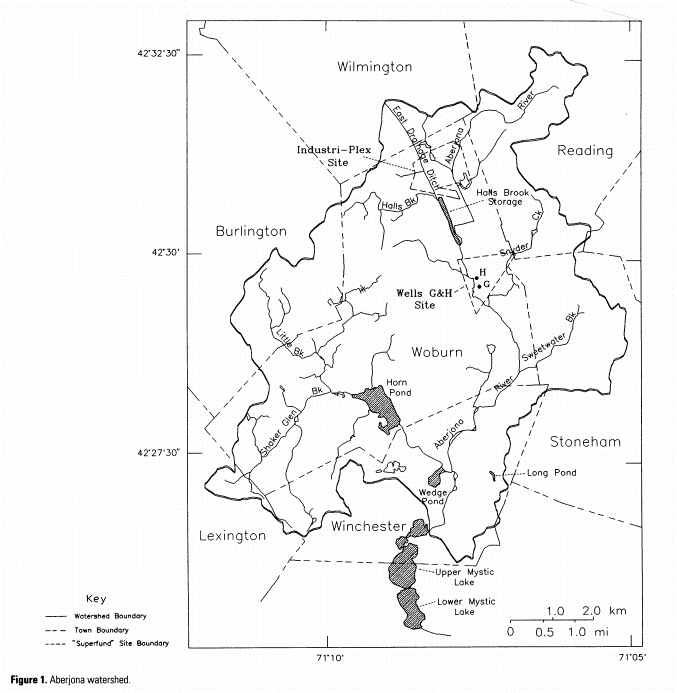
Water bodies and Superfund sites in Woburn, MA 27
The quality of Woburn’s municipal water supply had throughout the twentieth century been the subject of residents’ complaints, made to an array of state and local regulatory bodies. But it was not until popular organizing and advocacy by the victims’ families created the media spotlight needed that regulators began to address the water contamination.
In Paula Diperna’s 1985 book Cluster Mystery, a comprehensive account of the cluster of child leukemia diagnoses and deaths in Woburn, MA, she shared accounts from residents who had grown up in the Boston suburb in the 1950s and 1960s. Some of the residents who had lived near an inlet of the Aberjona River, Hall’s Brook, recounted their experience with the water. One resident described one of the children’s delightful pastimes—throwing ‘mudpacks’ at each other. These chunks of mud along the brook would later prove to be earth, congealed together by chemical residue. 28
Origins of a Mill Town’s Toxic Residue
In 1803, the Middlesex Canal was officially opened, dug over the preceding decade to connect the Merrimac River with Boston Harbor. In the decades that followed, the canal facilitated rapid growth of several profitable industries in Woburn — leather, shoemaking, and dyes. Mills along the Aberjona River would power the factories producing these goods.
From 1827 to 1893, much of the area surrounding Horn Pond was used by the Dow Tannery, the largest leather tannery in the city, at a time when Woburn was one of the leading leather-producing cities in all of the country.29 In her book Woburn: Hidden Tales of a Tannery Town, Marie Coady retells the story of the tannery—
For a time, the tanning of leather implemented natural products such as the bark of trees, plants, etc., but as Woburn became a leading leather producer in the United States and offered much-needed employment, owners began looking for faster and more efficient ways to tan leather. That led to the use of chemical techniques that employed chromium, lead, copper and zinc amalgams that turned the liquor pits into a source of contamination that impacted not only the citizens of Woburn but everyone downstream…As the tannery grew and the techniques of tanning became more volatile, the refuse dumped into Horn Pond became more than anyone bargained for.
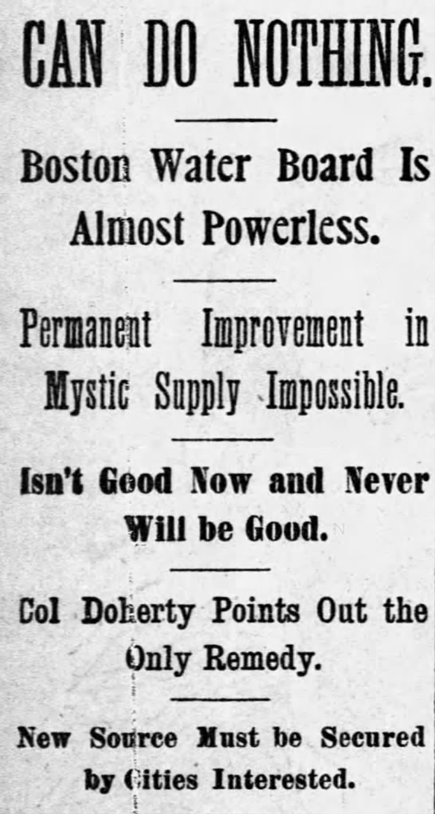
Boston Globe, March 9, 1895, page 6
Woburn residents were falling ill due to the chemical biproducts produced by the very industry that was primarily responsible for the city’s growing prosperity. Coady continues on to document a letter to the editor in the Woburn City Press, published in 1889—
Would it not be wise to take the warning before it is too late, that your children and future generations may not point to you in condemnation, not only because you have allowed such beauty to be despoiled, but because you have allowed it to be polluted into a breeding place of miasma and disease? 29
Mercifully, on April 29th, 1893, the Dow Tannery burst into flames. Residents’ efforts to extinguish the flames were futile—
In the end, the Stephen A. Dow tannery was so badly damaged that it was decided that they would not rebuild. Instead, the very next day they leased the Maxwell tannery in North Winchester and picked up where they left off, making sure their employees were not out of work even one day. For years, the charred ruins of the Dow tannery continued to blight the neighborhood until it finally came under the control of the Metropolitan Parks Commission. The commission, with a great deal of urging from the city, demolished the tannery to make way for the new Woburn Parkway, which opened in August of 1914. But from what I’ve been told by people who lived through that transformation, most of the tannery still exists under the few layers of soil that were used to cover the debris.29
Meanwhile, Woburn’s chemical and dye manufacturing industries were substantially picking up production throughout the second industrial revolution. Woburn Chemical Works, later renamed Merrimac Chemical Company, opened in 1853.30 From 1853 to 1931, Merrimac Chemical and other manufacturers of arsenic-based insecticides, sulfuric acid, phenols, TNT, and chemicals for the leather-tanning industry occupied this area of Woburn.31 Between 1899 and 1914, the Merrimac Chemical Company had grown to become the largest producer of arsenic-based pesticides in the country.⁵
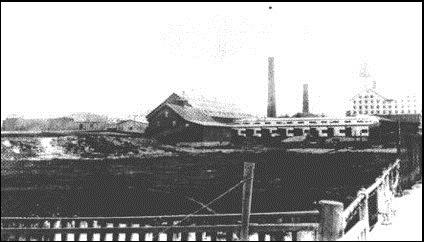
Rear view of the Merrimac Chemical Company 32
The careless disposal by Merrimac Chemical of the wastes from their manufacturing processes gravely impacted surrounding communities. Scientists have estimated that from 1888 to 1929, between 200 and 900 metric tons of arsenic were released into the surrounding ecosystem as a result of pesticide and sulfuric acid manufacturing activities, with approximately 13 metric tons traveling down the Aberjona River to the Mystic Lakes.32
Both residents and regulators were cognizant there was ecological harm being done, but investigations were disjointed. An 1895 examination by the Massachusetts State Board of Health reported that a major source of the town’s public water supply, Horn Pond, was seriously polluted by the tannery and other manufacturing establishments. A follow-up investigation in 1903 reported that the filtration of the water from Horn Pond was becoming less thorough, as shown by the increase in free-flowing ammonia and iron.
By 1906, the Board of Health warned that Horn Pond Brook and its tributaries in Woburn were the “most seriously polluted stream in the water-shed of the Mystic River above Upper Mystic Lake, wastes that entered streams that ran beneath factories or through factory yards as well as by human wastes.”30
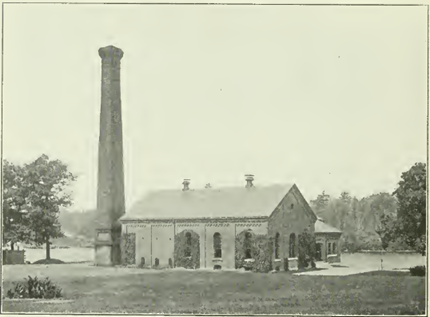
Horn Pond Pumping Station, Woburn, MA 1909 33
In contrast to these observations from the Board, the town’s electric company, the Edison Electric Illuminating Company published a charming brochure about the town in 1909, positing —
The City Water Works supply drinking water of excellent quality. This comes partly from supplementary wells; but mainly from a filter gallery near Horn Pond, a beautiful sheet of water which besides serving its useful purpose is one of the scenic attractions of Woburn. The water is pumped both directly and to a reservoir on Horn Pond Mountain. The supply is always plentiful and there is ample pressure while the thorough distributing system and the more than fifty-seven miles of mains in use make the water generally available…
Various opportunities for outdoor recreation are presented in Woburn. The head waters of the Mystic River are in Woburn, and various ponds or lakes add diversity to the scenery. Horn Pond Mountain and other elevations afford charming views. The vicinity of Horn Pond is attractive while the pond itself is regarded as the best lake for canoeing in Eastern Massachusetts.33
By 1900, Merrimac Chemical had built facilities across more than 400 acres and was one of the largest producers of chemicals in New England.
On Sept. 7, 1923, the MSBH wrote the Woburn Board of Health warning that Horn Pond was “a most objectionable source from which to take water for water supply purposes.”
One resident turned to the Massachusetts House Ways and Means Committee, writing the committee in a letter that, between July and September 1924 —
The City of Woburn had no water fit for human consumption…some chemicals were put into the water to kill the bacteria, which was the cause of much sickness. The more a person drank of the water, the thirstier he would get, so that a person ’s energy was greatly reduced.30
Dependence upon Horn Pond water, however, continued with as much as half of the total amount of the public’s water supply being pumped directly from the pond.

The Boston Globe, Sunday, October 14, 1923
In its 1928 catalog, the Merrimac Chemical Company noted that it deliberately accumulated piles of industrial wastes, with the expectation that a use for the by-product would eventually be discovered. It identified these by-product materials as calcium sulphate, oxide of iron, pyrites cinder, sulphate of lead, calcium carbonate, bauxite waste mud, and “others.”30
Chemical Revolution
In 1929, Merrimac Chemical was acquired by the Monsanto chemical company. Monsanto maintained the day-to-day operations of Merrimac as one of its divisions until 1934. Among the chemicals Merrimac manufactured pre- and post-acquisition were phenol, benzene, trinitrotoluol (TNT), picric acid, toluene, and sulfuric acid. Then from 1927 to 1968, the site was used to manufacture glue and grease from tanned animal hides.31
By the late 1930s, industrial wastes at the site were piling up—filling lowlands, wetlands, and ponds. These wastes mixed frequently with the municipal sewage that frequently overflowed from the town’s inadequate sewage system.30
After changing hands several more times during these years, the manufacturing complex would ultimately be sold by Stauffer Chemical Companies to a commercial developer, the Mark Phillip Trust (MPT), in 1969.
In the latter part of 1964, Woburn’s Department of Public works activated a new municipal well—”well G,” followed by “well H” in the first half of 1967. Not long after, residents of the neighborhoods served by these wells began reporting strong chemical tastes in their tap water. The water was not even suitable for laundry, as it would ruin the clothing it came in contact with.
In 1965, the town opened a new landfill in a swampy area that drained into a ditch at the northern edge of the Aberjona aquifer. Years later, the mayor of Woburn at the time admitted that the landfill was “never run properly because we dumped into brooks. It should have never been put there because it was in the middle of a wetlands area.”30
In late August 1969, a group of East Woburn residents presented the Mayor with a petition protesting the quality of their water. He agreed to close wells G and H by October 1, but they were reactivated by the following spring due to limits in supply.
Both wells would, over the ensuing decade, follow the cycle of being decommissioned due to taste and quality complaints, only to be recommissioned shortly thereafter due to supply shortages.30
Meanwhile in 1970, at the site formerly owned by Merrimac Chemical, then by Monsanto, then by Stauffer Chemical Companies, the Mark Phillip Trust initiated plans to build an industrial park called IndustriPlex 128, named after nearby route 128. The IndustriPlex site was located just north of G and H.

Contaminated Wells and Nearby Industrial Contamination Sites 34
As the MPT excavated the land, they extracted buried animal glue manufacturing wastes, which released a very strong and pervasive “rotten egg” odor. Despite repeated citizen complaints and notices of violations issued by the Massachusetts Department of Quality Engineering (MDQE), the MPT continued its development of the site.35 In doing so, pockets of stockpiled wastes leached into nearby soils, ponds, and wetlands, while hydrogen sulfide gases entered into the atmosphere.36
After repeated violations of the DEQE’s administrative orders, the Massachusetts Office of the Attorney General filed suit against the MPT on behalf of the DEQE. In 1977, the Superior Court issued an order prohibiting the MPT from disturbing two small parcels of land where the bulk of the remaining glue manufacturing wastes were believed to be buried.36 The order did not address the substantial odor and runoff produced by animal wastes that the MPT had already excavated and stockpiled.35
Residents in the section of Woburn served by wells G and H were growing increasingly uneasy, but not simply from their concerns with the smell of their tap water, or the fact it would stain their clothing. During the summer of 1979, nationwide publicity about the Love Canal toxic waste dump coincided with extensive local publicity about possible environmental hazards in Woburn, causing some local residents to wonder if the town's cancer rates there were higher than average—in the ten years between 1969 and 1979, the town saw twelve diagnoses of child leukemia.37
At the urging of a Woburn doctor, the Massachusetts Department of Public Health (MDPH) and the Centers for Disease Control (CDC) conducted an investigation which confirmed a significantly elevated incidence of childhood leukemia in Woburn. Twelve cases were observed in the town, where 5.3 cases were expected in the ten-year stretch. Nine of the twelve children diagnosed had acute lymphocytic leukemia, and all cases were diagnosed before the patients reached 15 years of age.38
Furthermore, at the time of diagnosis, the leukemia cases were concentrated in the eastern part of Woburn, just north of Walker Pond. Six of the victims lived within the borders of census tract 3334, in an area approximately a half-mile in radius. The CDC report documented that the expected probability that 6 or more of the town’s 12 cases would occur in this area, which contained only 17% of the town's population in the 1- to 14-year-old age group was less than 0.01%. The six cases in this census tract were 7.5 times higher than expected.
Childhood leukemia incidence for the rest of Woburn was not significantly elevated.38
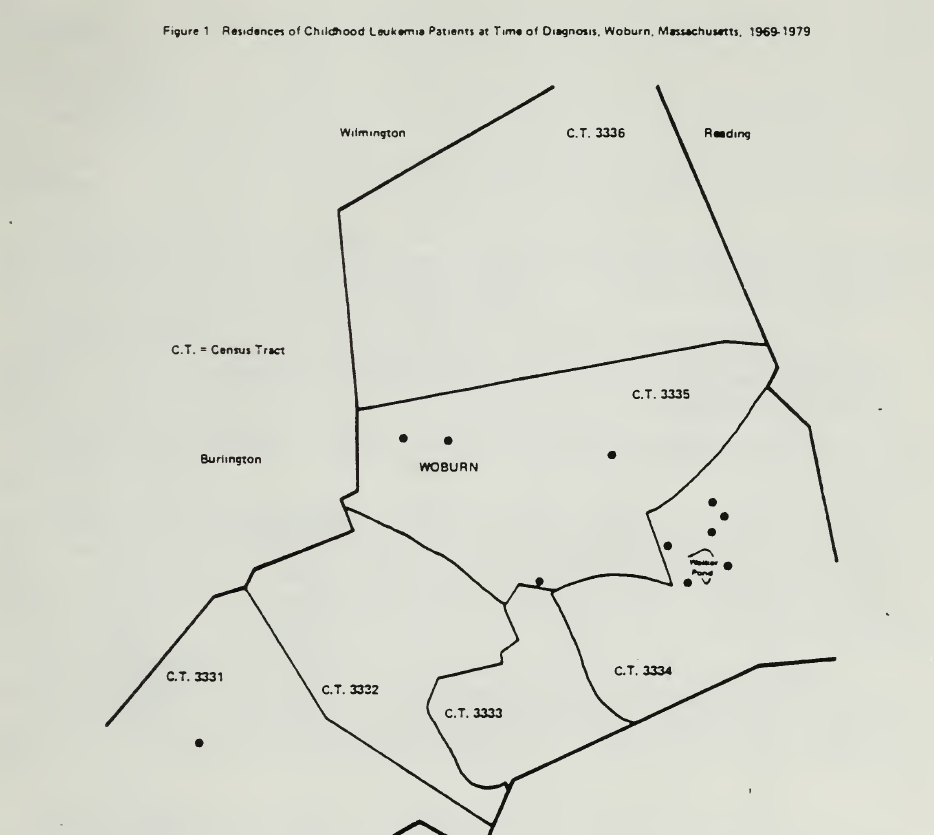
Residences of Childhood Leukemia Patients at Time of Diagnosis in Woburn, Massachusetts from 1969 to 1979 38
The findings only validated what had by then become clear to Woburn residents—something within their surrounding environment was contributing to—if not outright causing— the tragic losses of children in the community to specific kinds of leukemia.
Anne Anderson, a Woburn resident whose son Jimmy’s short life was spent battling the leukemia until he succumbed to it at age 12, was among the first to suspect the correlation—a suspicion that was met for years with broad skepticism until the evidence was indisputable. When asked about the ordeal for a 2004 report to the EPA about the Woburn disaster, Anderson was quoted—
From the time we moved here, the water was bad in the summer. It had an unpleasant odor and a terrible taste. My mother brought jars of MDC water when she came to visit. The kids used to always ask for ‘Nana water.’ It was like a mother’s milk, for God’s sake. She still brings it when she visits.
After the CDC report was released, Anne Anderson and other residents formed a community advocacy group they called For a Cleaner Environment (FACE). Anderson alone could not have forced the state government to take further action; community organizing was critical to advancing their critical situation onto the national media’s radar.
A 1981 study entitled Woburn: Cancer Incidence and Environmental Hazards 1969-1978 by the CDC and the Massachusetts Department of Public Health confirmed the presence of elevated levels of kidney cancer and childhood leukemia in Woburn. But the study’s Conclusions section led with the following two paragraphs—
The information gathered thus far fails to provide evidence establishing an association between environmental hazards and the increased incidence of childhood leukemia and renal cancer in Woburn. Interviews with parents of leukemia cases, two groups of matched controls, and family members of renal and liver cancer cases revealed no associations between environmental factors and the disease.
The investigation has established that the overall incidence of childhood leukemia was significantly elevated in Woburn and that there was a significant concentration of cases in one particular area of east Woburn. The hypothesis suggesting that the increase in leukemia incidence was associated with environmental hazards in Woburn, and specifically with the contamination of drinking water supplies, is neither supported nor refuted by the study findings.39
The study concluded nothing, as the study’s data for 1969-1978 was compared with the data from the years prior to 1969, which did not exist. (Notably, the American Cancer Society still categorizes chemical contamination of groundwater as an “Uncertain, unproven, or controversial risk factor” for childhood leukemia.)
The affirmation of the injury inflicted upon the residents accompanied by the state’s inaction fueled FACE’s community organizing. Seven months after their initial meeting, FACE convened a group of state and federal agency representatives to discuss the plight of Woburn residents. At that meeting, the EPA agreed to investigate the wells.40
While the extent of the public health crisis was being determined by federal, state, and local health department investigations, environmental regulators faced the formidable task of testing the soil throughout the town for a multitude of contaminants, and then tracing their source(s). The undertaking would only grow more challenging, as their investigations uncovered several more toxic waste sites in Woburn.
On May 4, 1979, in a vacant lot next to the Aberjona River, construction workers found 184 abandoned polyurethane barrels containing unknown substances near the newly constructed IndustriPlex, and reported this to the MDPH. The department’s director, Richard Chalpin, fully aware of the Love Canal disaster, knew immediately to be concerned about the nearby groundwater. He called for testing of the nearby public drinking supply wells, which revealed the presence of toxic metals including arsenic, lead and chromium.
The DEQE, who had been trying to shut down the construction of the IndustriPlex, began to test water from the wells as well. On May 22, they informed the Woburn Board of Water that analyses of water samples from wells G and H indicated “the presence of trichloroethylene (TCE) concentrations of 117.6 parts per billion in the sample from well H and 267.4 parts per billion in a sample collected from well G respective.”30 At time of this writing, the EPA’s maximum allowable level of TCE in drinking water is 5 parts per billion.41 It is considered a carcinogen by all routes of exposure.42
The contamination of the water in these wells G and H, though, did not solely originate from the businesses located in their immediate vicinity.
In July 1979, EPA field investigators discovered an abandoned lagoon, spanning nearly an acre in surface area with depths of up to 5 feet. Within it was a slurry of toxic materials including lead and arsenic, the latter in concentrations as high as 1,050 parts per million. The investigators estimated that these materials had been deposited into the ground by manufacturers between 1899 and 1915.38
These chemical deposits were unrelated to the already documented pits of buried animal hides and slaughterhouse wastes that were discovered earlier that summer.

The Virgin Islands Daily News, 1980
The EPA identified the MPT and a group of 25 other businesses as being partially responsible for the ecological damage to the area around the IndustriPlex. The businesses, collectively called the Site Settling Defendants, entered into Consent Decrees with the EPA. Consent decrees under the Superfund act constitute a judgment that binds the parties who sign the decree, but are not an admission of liability.43
Citing the inability to generate sufficient capital, the MPT was the sole party not to have complied with the conditions of the Consent Decrees.35,36
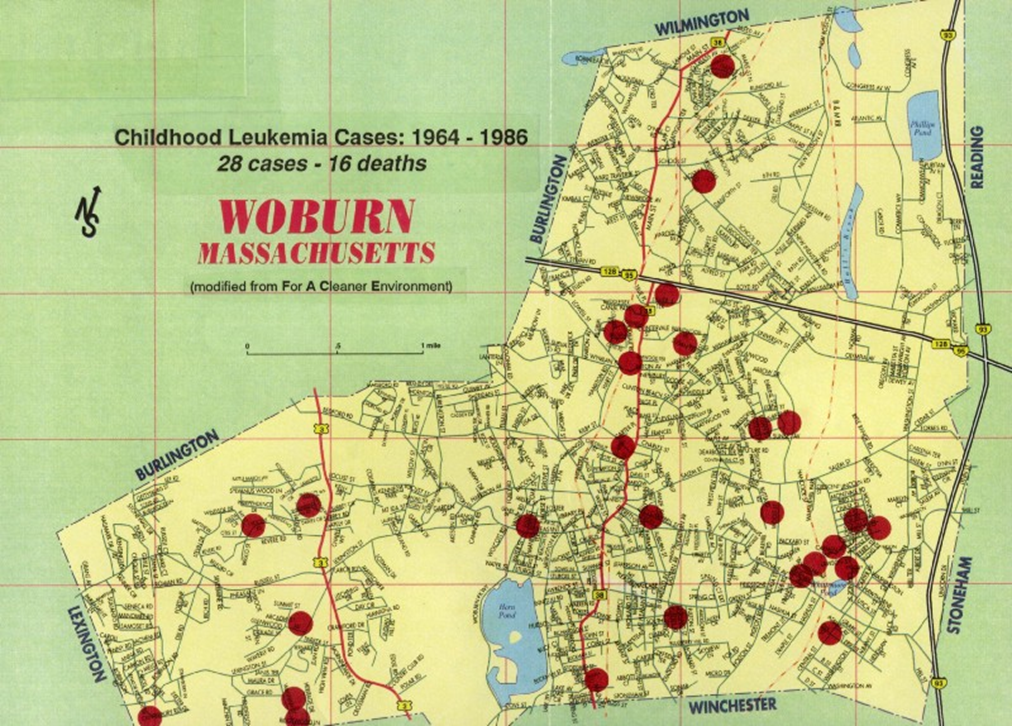
Source: For a Cleaner Environment (FACE, 1986)36
Living near environmental waste sites has measurably grave consequences, shown in longitudinal studies of the residents of Woburn, Niagara Falls, and communities that have faced similar levels of environmental contamination.
There are countless challenges faced by victims of these communities in holding polluters accountable, but also consider that it is far easier to document changes to the health of those who are already born than to prenatal victims.
There is significant research into how genetic development of the human body is impacted depending on where the mother lives. No organism, including humans, has a destiny independent of its environment, writes Dan Agin, professor of Molecular Genetics at the University of Chicago in his 2010 book, More than Genes. Agin details the findings of one such study—
In 2003, researchers reported a study of 48,197 mothers and their 59,397 children. The children were followed until age 7, and the group included 623 twin pairs. The report concluded that in poor families nearly all the variance in IQ is accounted for by a combination of effects in both the prenatal and post-natal environments, and that the contribution of genes to IQ variance in such families is close to zero. In contrast, in affluent families, the result is almost the reverse. The implication is that among poor children genetic differences contribute almost nothing to the measured variance of IQ because environmental damage, both prenatal and postnatal, overwhelms all other variables in accounting for IQ variation.
In contrast, in the middle and upper classes, in which prenatal and postnatal damage to the nervous system is much reduced and hardly variable from one family to the next, genetic differences account for most of the variation in IQ. In plain language, for middle- and upper-class children, differences in IQ can be explained mostly by genetic differences, while in lower class children, differences in IQ are explained mostly by nongenetic differences (prenatal and postnatal environments).44
Furthermore, one’s mere proximity to hazardous waste sites presents myriad routes of exposure to the human body. A growing body of evidence suggests that there is a measured impact that one’s housing and neighborhood has on their health outcomes, some exacerbated by whether one is able to afford amenities such as air conditioners to filter air particulates.45-52
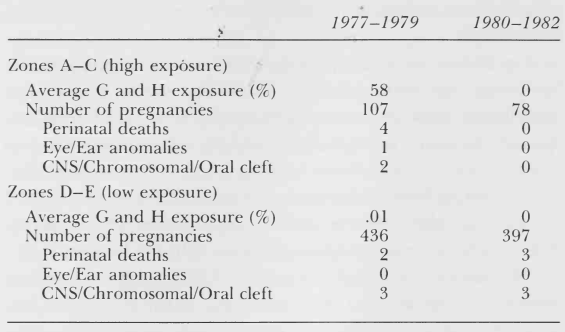
Adverse Pregnancy Outcomes in Areas of High and Low Exposure before (1977-1979) and after (1980-1982) Closure of Wells G and H 34,53
Causal Indeterminacy
By the time the victims of the water contamination had been able to put together a plausible case, the defendants were too numerous for any one party to be proven responsible, and many guilty parties had long since departed.
Eight families organized to file a class action lawsuit in 1982 against the owners of the land from which the majority of the municipal well contamination had originated. Children in seven of the eight families had contracted leukemia, the eighth lost her husband to it. Five of the children died from leukemia or complications of having leukemia. The spouse of one plaintiff contracted acute myelocytic leukemia and died.
While the court case proceeded, FACE continued its advocacy and held numerous public meetings to mobilize community leaders and local residents.40 One member interviewed for Brown and Mikkelson’s No Safe Place stated—
[FACE] accomplished an awful lot, and it has given credibility to this kind of problem. And it has given people courage to stand up and make noise about something that they think is wrong in their community, and get attention.34
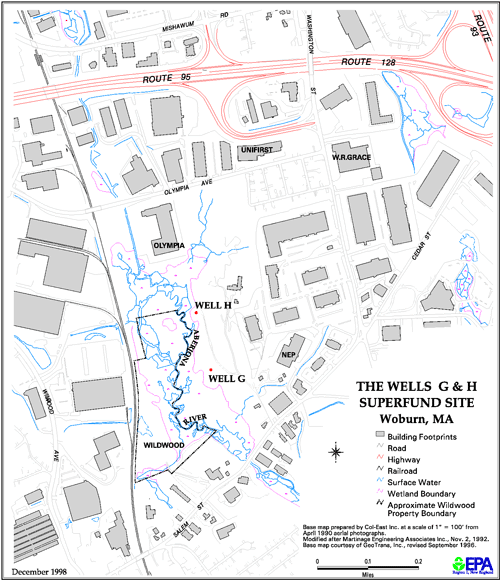
Source: Harvard University54
The defendants were W.R. Grace & Co., UniFirst Corporation, and Beatrice Foods, Inc.¹² Journalist Dan Kennedy reported on the case throughout its proceedings, often critical of the families’ counsel, Jan Schlichtmann. In 1998, he outlined Schlichtmann’s reasoning for naming the defendants—
Grace owned a plant that manufactured food-packaging equipment under the Cryovac brand name, and used TCE to clean tools and thin paint…Beatrice purchased the John J. Riley Company tannery — and Riley’s legal liability — just a few months before the wells were shut down. A 15-acre undeveloped property adjacent to and owned by the tannery was heavily contaminated, and Schlichtmann tried — with little success — to show that the tannery itself (and thus Beatrice) was responsible. UniFirst operated a dry-cleaning plant that used PCE.55
Despite it being a civil case — meaning the victims would only need to show the jury that the majority of the evidence pointed to the defendant being liable — the lawsuit faced significant hurdles and in the eyes of some, a suspiciously adversarial judge in Walter Skinner.
For the first five months of the trial, the Woburn families would be forbidden from making any public comment due to a gag order placed on them by Judge Skinner. He ultimately lifted the order only after complaints from the Massachusetts Civil Liberties Union were publicized in the media.34
Due to the Skinner’s decision to bifurcate the lawsuit, the residents’ legal team would first need to show the jury that the defendants’ properties were the likely origin point of the toxic chemical that had contaminated the two wells. If successful, they would then need to show that the children’s deaths from leukemia were attributable to the contamination.32 Finally, that injury would need to be assigned some dollar value in damages. Crucially, this meant that for the proceedings to even reach the portion of the trial focused on damages to the residents’ health, the plaintiffs would first need to demonstrate the defendants’ culpability.

Woburn Daily Times Chronicle, 198656
Years later in 2009, author Paul Kix wrote for Boston magazine about the challenges presented to Schlictmann by the judge and the opposing counsel—
Jerome Facher, a senior partner at the Boston law firm Hale and Dorr and a lecturer at Harvard Law School, convinced Judge Walter Skinner to break the immensely complicated trial into two parts. Officially, it was Skinner’s decision; such was the case’s complexity, he reasoned. But the bifurcation benefited Facher and the defense attorneys for W. R. Grace in two ways.
First, it gave the defense teams two trials, which put an added burden of proof on Schlichtmann. The first phase of the trial would test the scientific validity of the plaintiffs’ claims. Were the tannery and W. R. Grace responsible for the wells’ contamination? If the jury believed that, the case would move on to the next question: Were the chemicals in the water responsible for giving the children cancer?
Second, delaying the medical portion meant Schlichtmann couldn’t put the Woburn families on the stand until the trial’s latter phase. Their tragic losses were his most compelling pieces of evidence. And now, if he wasn’t successful in the first phase, the families wouldn’t take the stand at all.
Facher worked to ensure that. The trial opened in March 1986 and lasted until late July—79 days of testimony, evidence, and Facher’s objections and ruthless cross-examinations. Already Facher had succeeded in taking a case about dying children and turning it into one of soil samples and river flow, with academics making competing, esoteric claims.57
The lawsuit went poorly for the plaintiffs by virtually any measure, though in retrospect there were likely few winning strategies.
Consider the evidence required to show that the environmental wastes, deposited by a multitude of parties, had more likely than not caused the children’s leukemia. Legal scholar Robert Blomquist wrote about the case for the Cornell Law Review in May 1996, documenting the challenges presented by the case having had both an ‘indeterminate plaintiff’ and an ‘indeterminate defendant.’
One of Jan Schlichtmann's principal problems in litigating the Woburn case was identifying all of the “victims,” and potential tort plaintiffs, of the hazardous waste groundwater contamination out of Woburn's total population of 36,000… Perhaps the genetic background of the children had initiated the leukemias. Maybe health habits (such as the quality of diet, exercise and medical care)had triggered the disease in some of the children. It was also conceivable that some or all of the Woburn leukemia cases had been caused by other environmental exposures such as toxins in the air or suspected carcinogens in common household products, unrelated to the elevated levels of chemicals found in the east Woburn groundwater. Similarly, because of the latent and chronic quality of many toxic injuries, Schlichtmann could not be sure that everyone actually harmed by the contaminated well water knew that they had, in fact, been harmed…
In addition to the problem of indeterminate plaintiffs, another of Jan Schlichtmann's principal problems in litigating the Woburn case was the indeterminate defendants problem. As Schlichtmann asked himself at the beginning of his involvement in the case: “Whose chemicals had polluted the wells? Who had dumped these chemicals, and when had they gotten into the water supply? Had they in fact caused leukemia?”58
Prior to the trial, Schlichtmann and UniFirst settled out of court for $1.05 million. Beatrice Foods, which had owned a tannery on the Woburn site and retained liability for the plant, was found not responsible for any contamination by the presiding judge.59
In 1986, after nine days of deliberation, the jury found W.R. Grace liable for contaminating wells G and H. Judge Skinner proceeded to throw out their verdict, though, on the grounds that he found some of their answers to the questions about the hydrogeological data to be confusing. Those questions they had been asked were asked by Judge Skinner himself, questions he would also later dismiss as overly confusingly worded.34
W. R. Grace ultimately settled with the families for $8 million, without having to admit responsibility for the contamination. Most of the money went toward legal fees. After years of turmoil, each family received less than $300,000 from the settlement.
I thought more positive things were going to come of it. In retrospect I guess that Grace really didn't have anything to lose, or hasn't lost much at all, even monetarily, or in any way, I guess. But when we settled, that wasn't necessarily the case, but as I get further away from it, I don't think that they really suffered much at all.
-Woburn mother after W.R. Grace settlement 34
The dollar amount of these settlements, while uninspiring, are illustrative of a broader set of challenges faced by the plaintiffs of environmental crimes. Economics scholar Harold Barnett documented these challenges in his book Toxic Debts and the Superfund Dilemma:
1. Some state statutes of limitations for tort actions begin to run at the time of defendant’s tortious act. These traditional periods are often violated by the time required for toxic waste leakage and migration, for exposure to contaminated surface or ground water supplies, for the onset of an injury such as cancer with long latency periods, and for awareness of the relationship between exposure and injury.
2. While several tort law principles such as strict liability, negligence, trespass, and nuisance are available in theory, the fact that the plaintiff may be indeterminate renders them inapplicable. We may know that a group of people has a specific type of cancer and that some of them contracted that cancer from exposure to the defendant’s waste; however, we will not know which individuals in that group were affected by the waste.
3. A defendant will be held liable if it is proven to be more likely than not that the defendant’s action caused the plaintiff’s injury. A plaintiff, however, typically can show only a causal link between exposure to a toxic substance and an injury. Further, medical and epidemiological evidence linking contamination to injury in a statistical sense may be excluded by evidentiary rules. Causal indeterminacy imposes great difficulties on the party with the burden of proof. High transaction costs combine with the uncertainty of eventual recovery to discourage many victims from suing and to encourage many who do sue to accept settlements which do not reflect the merits of their claim.60
If no organism exists nor forms independent of their environment, and proximity to toxic waste sites has a measured impact on one’s health outcomes, then a system in which some humans are left with no alternative but to live close to contamination sites would seem to most observers as distinctly unequal.
This makes FACE a particularly valuable case study of community advocacy for environmental justice, as their organizing had convinced not just Woburn residents but casual to onlookers to demand government action. In their book No Safe Place about the incident, Phil Brown and Edwin Mikkelson write—
Organizing a community contaminated by toxic wastes is extremely difficult and full of contradictions. The victims and their families, already suffering physical and emotional pain, must relive painful memories as they delve into the causes of their trouble… The Woburn community organized on a different pattern from most other toxic waste sites. Elsewhere we often see either a single community organization (as in Legler, New Jersey) or competing community groups with separate memberships (as in Love Canal). Alternatively, we may see a group composed of persons who have suffered specific health problems (as in Hardeman County, Tennessee).
Politicians such as Senator Edward Kennedy, Representative Edward Markey, state representative Nicholas Paleologos, and state senator Richard Krauss helped spread the word about the Woburn situation.
Still, Woburn's ascent to national significance must eventually be credited to conscious organizing efforts by the victims and their neighbors. They took “favorable” circumstances, created more of their own, and wove events into a tight web. In most other contaminated communities, victims fail to counteract government stonewalling. Woburn victims and their supporters showed unusual courage and persistence in withstanding so much hostility, obstruction, inaction, and ineffective action.34
As one of the victims’ father remarked—
What we did was a start, I think. That is square one. It did show the people out there that if you are wronged by a corporation that arbitrarily pollutes your water or your yard or your air or something like that, that, yes, there is an avenue that you can pursue to bring about a just [solution]—to cease it.34
___